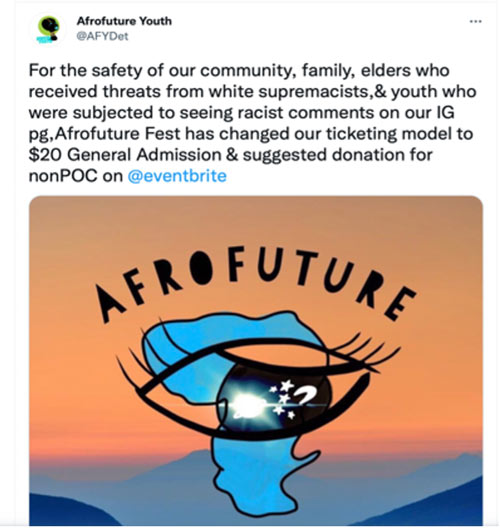
The term “Price Discrimination” may sound strange, but it is in fact a normal part of the world of commerce. Simply put, it is the business strategy of charging different prices to different customers based on a variety of criteria. In what is known as Third-Degree Price Discrimination, companies can adjust the prices of products and services according to the demographics of their consumer base, in order to attract more customers and maximize profits. As a staple of the entertainment industry, it is common to see discounted prices for veterans, students, or the elderly in places such as movie theaters, restaurants, and amusement parks. Within racial justice spaces, however, a “Fourth Degree” of Price Discrimination is slowly emerging that is rooted in reparationist policy and takes a practical approach to the reality of the racial wealth gap.
Needless to say, race-conscious pricing structures are inherently controversial. In the summer of 2019, for instance, the organizers of an Afrofuturist music festival in Detroit found themselves at the center of national debate when they decided to charge white people a premium in order to attend their concert in a historically Black neighborhood. Early bird tickets were set at $10 for people of color and $20 for white people, while General Admission tickets cost $20 for people of color and $40 for white people. The Washington Post notes that one of the organizers issued the following statement on Twitter for insight on their reasoning:
Often times when dope events happen in Detroit the cheapest tickets are bought and then sold by people not from the community bc they can afford them first, leaving higher price tickets as the only options left….Black and Brown people deserve access to quality events in their city and it isn’t fair when events happen in their city that they don’t have a chance of being a part of because people who don’t look like us take advantage and also have more access to collective wealth.
The story went viral, generating both support and backlash from the wider community, as people weighed in on the viability of such rationale for pricing tickets. Eventbrite, the popular event marketing website that Afrofuture Youth organizers depended on for hosting ticket sales, soon became aware of the issue, notifying the group that if they did not adjust their pricing structures, the event would be completely removed from the website. The organizers eventually made all tickets the same price for everyone, citing a need for the safety of their community in a social media post: “For the safety of our community, family, elders who received threats from white supremacists, & youth who were subjected to seeing racist comments on our IG pg,
Afrofuture Fest has changed our ticketing model to $20 General Admission & suggested donation for nonPOC on @eventbrite”

Although the Afrofuture Festival was unable to follow through on their original pricing plan, they did advance the larger conversation of tangibly addressing racial wealth disparity. Similarly, being confronted with disparity in the stories of two customers prompted Nigerian chef Tunde Wey to implement a radical social experiment at his lunch counter in Roux Carre, New Orleans. He would charge $12 to customers of color looking to buy his meals, while offering white customers the option of paying either the same $12, or $30 in acknowledgement of the racial wealth gap, after he shared a few statistics with them. Eighty percent of Wey’s white customers opted to pay $30 and the profits were redistributed to any Black customers who could use the money.
Tiered pricing structures according to financial ability are not necessarily new. In China, businesses target different cities with different strategies according to their ranking in a tier system that groups cities in terms of income level, infrastructure, and spending habits. However, in Western society, it is the additional layer of race added to financial ability that makes some people uneasy. If studies show that there is indeed a massive racial wealth gap due to the historical subjugation of black people—leaving white families today 13 times wealthier on average than black families—how can this fact be practically incorporated into pricing structures, particularly in the absence of reparations?
Sign up for our free newsletters
Subscribe to NPQ's newsletters to have our top stories delivered directly to your inbox.
By signing up, you agree to our privacy policy and terms of use, and to receive messages from NPQ and our partners.
Rudy Lucas and Christine Schmidt are two New York-based psychotherapists who found a way to do just that. Since 2015, they have offered racial literacy consultation workshops, where people of all backgrounds come together to engage in intimate discussions on racial identity and how it shows up in their lives. White-identified people pay $95 per session while people of color pay $50 per session over the course of a few weeks. Lucas notes that there was no “scientific algorithm” to their choice of prices, stating, “we just chose a number that seemed to be workable to the people in the marketplace that were utilizing our services.”
The idea for the race-conscious pricing structure was born out of their efforts to create a mission statement on reparations for a conference hosted by the Eastern Group Psychotherapy Society (EGPS), an organization of which they are both members. Lucas commented,
We began to read and listen and study and it became clear that one of the ways to approach it was to approach it from an individual level rather than an institutional top-down kind. We believe very strongly in reparations as policy, reparations as pronouncements, as moral documents that are pronounced by government, by institutions of one sort or another…but, while waiting to get to that place, the responsibility of seeing it as an individual moral standpoint became more and more clear to us and we embraced the pursuit of knowledge about reparations and its history. We took it down to a very complex set of facts and exciting ideas that we had considered. But the bottom line was start small.
Starting small is the crux of his advice to those wishing to implement similar reparationist policy in their pricing structures, warning that it is “too big a deal” to expect a statewide or even citywide rollout from the start. “Maybe some people do, but that’s not what we did,” he added. They also had to sway their colleagues at EGPS to understand and accept the gravity of reparationist policy, and the level of innovation required to create solutions grounded in such theory. They convinced EGPS to support them in hiring two Black psychologists to speak at the conference—Brian Nichols and Mildred Connally, both well-versed in “reparations as a financial statement.”
Once the race-conscious pricing structure was accepted and implemented, Lucas explained that there was not much pushback in the beginning. About two years passed before they started “feeling a sense from white identified people that this is some kind of reverse racism.” He views the later emergence of this resistance as “a reflection of the changing temporal that this nation was undergoing with 45 being in the role that he was and giving permission to put into words those things that had been going on all along but were in dark secretive corners.”
Overall, the resistance was minimal, and Schmidt, who is white, took on the task of explaining the reasoning behind the pricing structure to any hesitant white potential clients. Lucas did not participate in that aspect of the work. He commented:
Christine was willing to continue with that, I wasn’t. I took a position that said, people are dying, you know, this is not hyperbole. We don’t have the luxury of inviting you to contemplate the name on this kind of stuff. If you’re in a community that we are part of, and I’m a part of, I want you to know that people are dying and I’m tired and I’m old. And it is your chance to decide what side of history you want to be on. It was at a time approximately that we were seeing George Floyd bringing white kids out in the street. And the handwriting was on the wall that you are going to be held accountable, I would tell ‘em, by your grandchildren. You’re already being held accountable by your children. You don’t care about my children. You don’t care about the children that you see on school buses all through your day. But you will begin to hear from your own children and your own grandchildren, and you get the choice of what side of that you want to be on.
Rudy Lucas takes pride in being a self-described “lead sled dog” in the fight for racial justice. He changed his email greeting and online image to a picture of the lead sled dog in an Alaskan Iditarod team—a visual reminder that he is willing to push the envelope and influence the direction of his field on matters of race, power, and reparationist policy. And if race-conscious price discrimination is the risky business it has proven to be, Lucas and Schmidt are truly blazing a trail for their peers.












